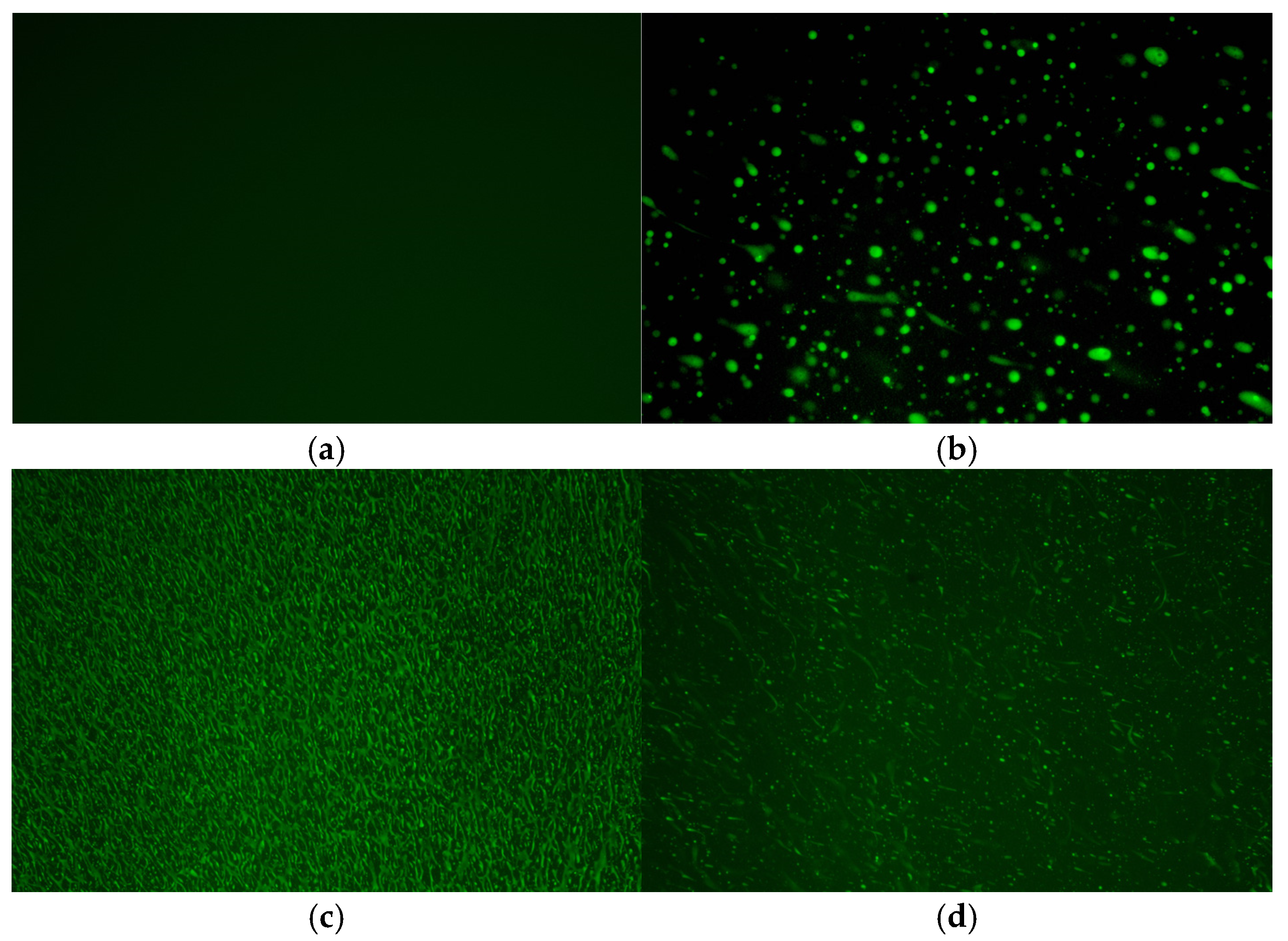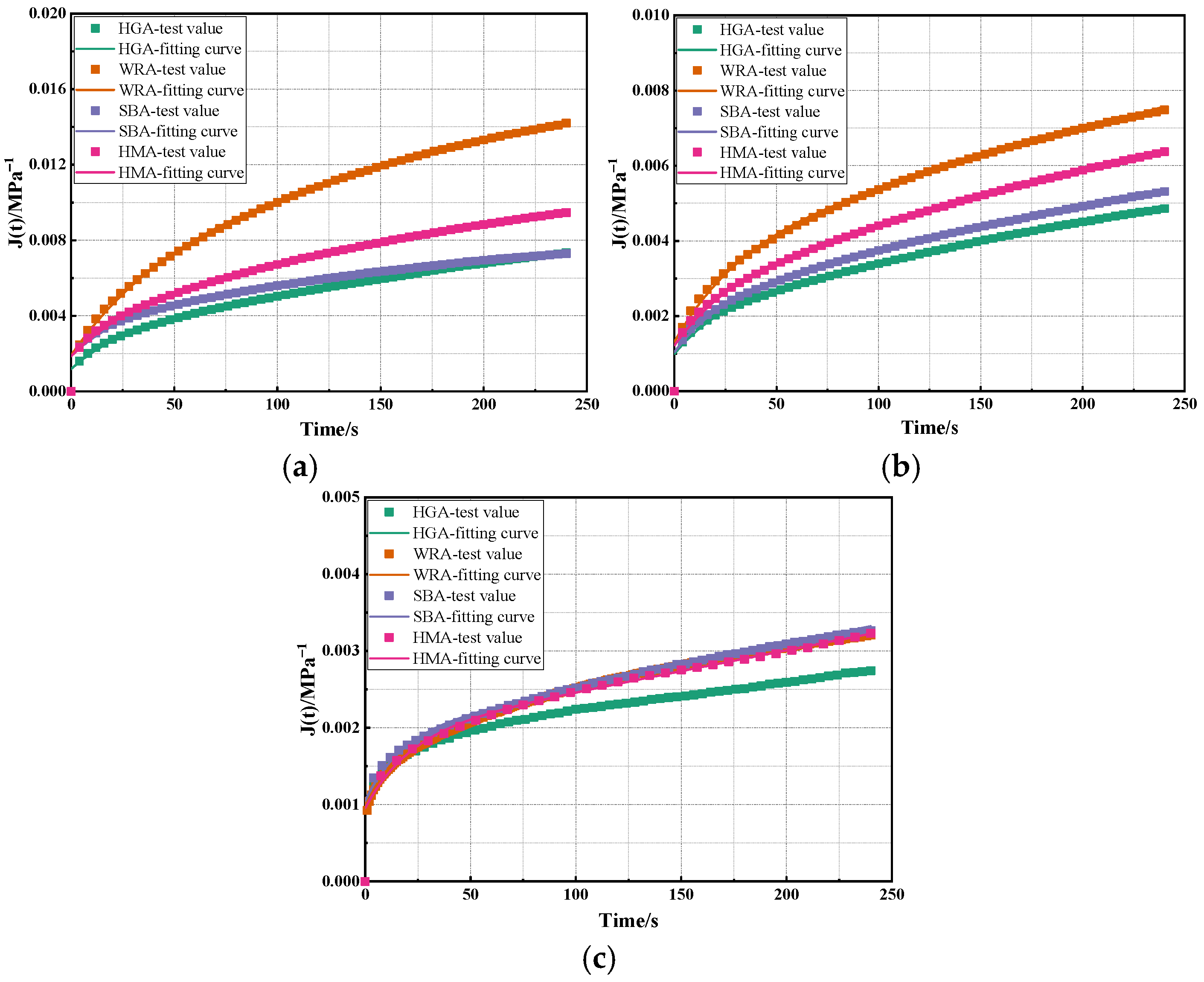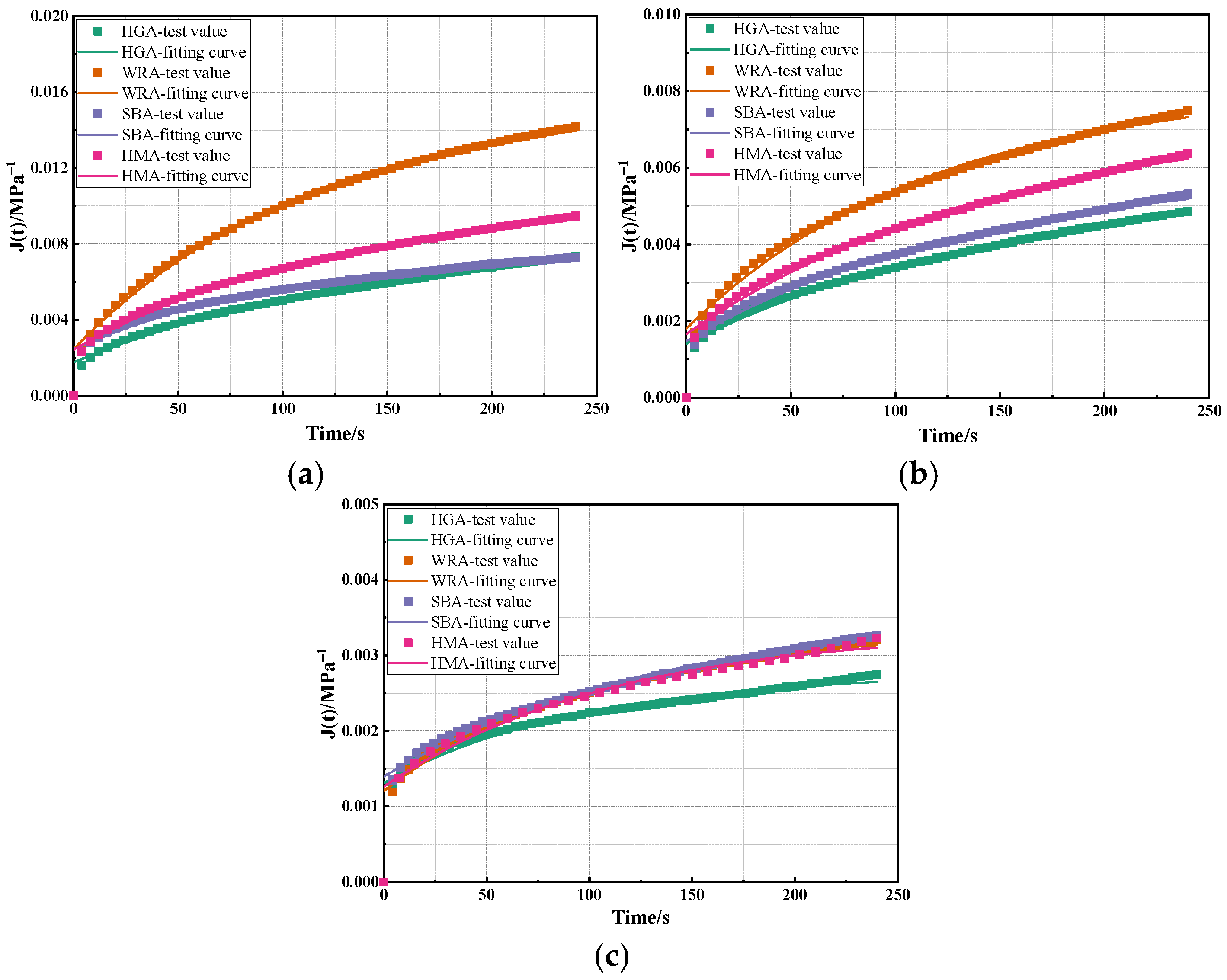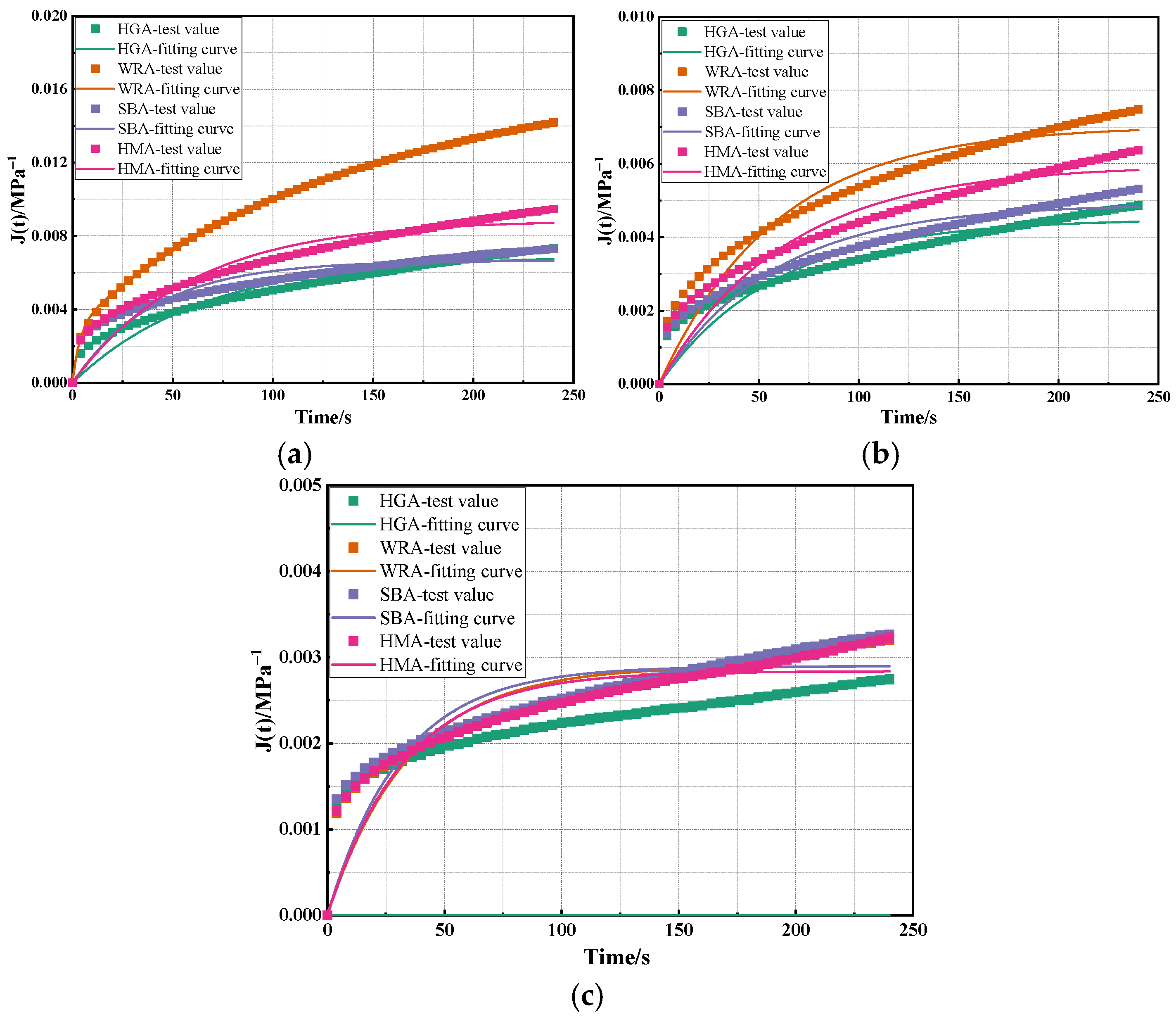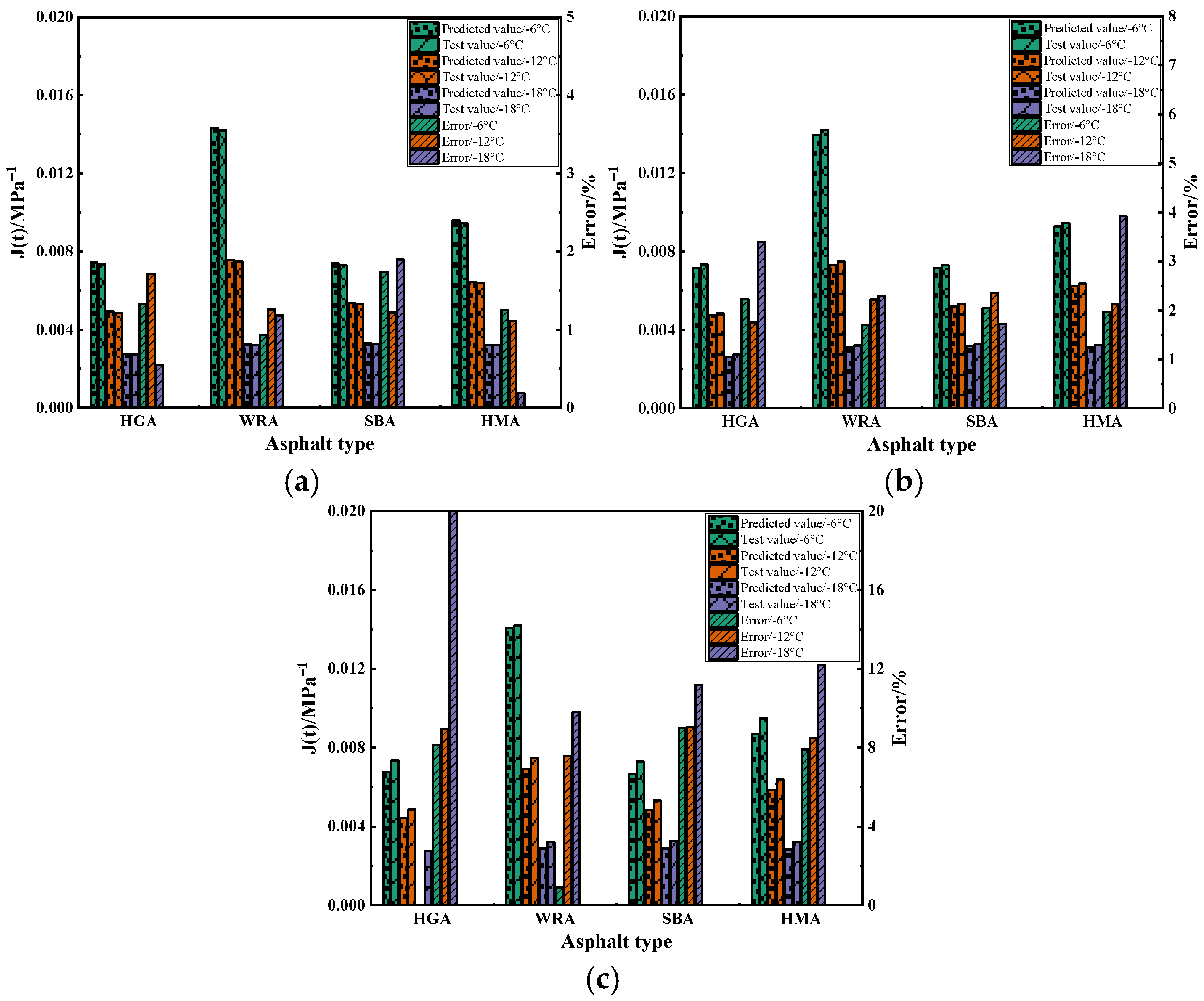1. Introduction
In the modern urban transportation system, asphalt pavement is an essential infrastructure for people’s travel, bearing heavy traffic pressure and enduring continuously increasing vehicle loads [
1,
2,
3]. However, for a long time, asphalt pavement has been subjected to erosion from harsh environmental conditions and ever-increasing traffic loads, which continuously elevates the risk of road damage and deterioration, accompanied by rising costs for road maintenance and repair [
4,
5,
6]. Therefore, the research and development of durable asphalt pavements have become a key link in ensuring road quality and extending their service life [
7,
8]. In recent years, high-modulus asphalt has gradually emerged as an ideal choice for the development of durable asphalt pavements, due to its excellent high-temperature performance and fatigue resistance. It is worth mentioning that durable asphalt pavement refers to asphalt pavement that can maintain stable service performance and extend its service life under the action of long-term traffic loads and natural environments. The main types of polymers that are commonly used to modify asphalt to improve its durability include styrene-butadiene-styrene block copolymer (SBS), ethylene-vinyl acetate copolymer (EVA), etc., and these can significantly enhance the deformation resistance, fatigue resistance, and aging resistance of asphalt. However, relevant studies have indicated that high-modulus asphalt generally exhibits poor low-temperature performance, which has become a significant factor restricting its application as a material for durable asphalt pavements [
9,
10,
11]. Against this backdrop, it is crucial to conduct in-depth research on the mechanism underlying the changes in the low-temperature performance of high-modulus asphalt. This not only provides guidance for improving the low-temperature performance of high-modulus asphalt to a certain extent but also contributes to promoting the sustainable development of durable asphalt pavements.
Currently, research on the low-temperature performance of asphalt mainly relies on the BBR test and physical properties tests such as penetration and softening point tests. However, the penetration and softening point tests can only reflect the ductility of asphalt in low-temperature environments within a certain range, and have significant limitations and are relatively one-sided in evaluating low-temperature performance [
12,
13]. In contrast, the BBR test characterizes the low-temperature performance of asphalt by measuring its creep behavior at low temperatures, which is more comprehensive and effective in evaluation, and it has thus become the primary method for evaluating the low-temperature performance of asphalt [
14,
15]. Liu [
16] evaluated the variation in low-temperature performance of polyphosphoric acid-modified asphalt with the aging degree using the BBR test, and found that the incorporation of polyphosphoric acid modifier could effectively improve the low-temperature performance of asphalt and reduce the sensitivity of asphalt’s low-temperature performance to its aging degree. Mohammed [
17] modified asphalt with two types of nanomaterials and characterized the low-temperature performance of the two modified asphalts using the BBR test. It was found that, although the incorporation of nanomaterials could effectively enhance the high-temperature performance and fatigue performance of asphalt, it would cause deterioration in the low-temperature performance of asphalt. Yan [
18] investigated the recovery effect of waste cooking oil on the performance of aged asphalt, and used the BBR test to focus on observing the variation trend of the low-temperature performance of aged asphalt before and after regeneration. It was found that waste cooking oil improved the low-temperature cracking resistance of aged asphalt by reducing the creep stiffness and creep rate. Zhang [
19] studied the modification effect of SBS modifier on different types of base asphalts and used the BBR test to investigate the low-temperature performance of two types of SBS modified asphalts. It was found that the low-temperature performance of both modified asphalts was significantly improved, but the improvement effect of SBS modifier on the low-temperature performance of asphalt weakened as the test temperature decreased. Notani [
20] recovered carbon powder through functional modification of asphalt and evaluated the low-temperature performance of the modified asphalt via BBR tests and viscoelastic modeling methods. It was found that carbon powder could serve as a potential option to improve the low-temperature performance of asphalt. Liu [
21] investigated the low-temperature performance of basalt fiber–rubber composite-modified asphalt using BBR tests and found that basalt fiber would deteriorate the low-temperature performance of asphalt to a certain extent. Xu [
22] studied the prediction of asphalt’s low-temperature performance by combining BBR and DSR tests, and proposed a method for predicting the low-temperature performance of asphalt based on a rheological model. Marasteanu [
23] conducted a comprehensive analysis of asphalt’s behavior at low temperatures and further discussed the development prospects of testing methods for asphalt’s low-temperature performance by combining BBR tests with various low-temperature models. The above research results indicate that the BBR test has become the primary research method for evaluating the low-temperature performance of asphalt at present. However, most current studies on low-temperature performance only evaluate asphalt’s low-temperature performance through low-temperature creep parameters, while in-depth analysis of the constitutive relationship of asphalt’s low-temperature performance is still lacking.
The low-temperature performance of asphalt materials is directly related to the crack resistance of pavements in cold environments [
24]. An in-depth investigation into the constitutive relationship of their low-temperature performance can reveal the deformation laws and performance evolution mechanisms of asphalt under different low-temperature conditions from the perspective of mechanical response mechanisms, providing a theoretical basis for the targeted improvement of asphalt’s low-temperature crack resistance [
25]. Especially for high-modulus asphalt, although it has become an important choice for long-life pavements due to its excellent high-temperature stability and durability, the issue of low-temperature brittleness has always been a key bottleneck restricting its popularization and application [
26]. Therefore, conducting research on the constitutive relationship of the low-temperature performance of high-modulus asphalt holds significant practical significance. Against this backdrop, this study selects four representative high-modulus asphalts (a high-modulus agent-modified asphalt; a high-content SBS modifier-modified asphalt; a waste rubber powder composite-modified high-modulus asphalt; and a high-modulus asphalt prepared from hard asphalt) as research objects, determines their low-temperature creep characteristic parameters via BBR tests, and, with these as fundamental data, introduces three typical viscoelastic constitutive models, respectively, to systematically investigate their low-temperature viscoelastic constitutive behaviors. To screen out the model most suitable for characterizing the low-temperature creep properties of high-modulus asphalt, this study further employs the GRA model to quantitatively evaluate the three constitutive models based on dimensions such as parameter stability, fitting accuracy, and significance of physical meaning. This study aims to clarify the low-temperature constitutive relationship and applicable models of high-modulus asphalt, thereby providing a scientific reference for the optimization of the low-temperature performance, material selection, and engineering application of high-modulus asphalt and facilitating its wider application in durable pavement engineering.
